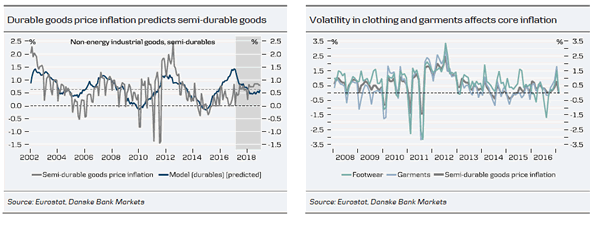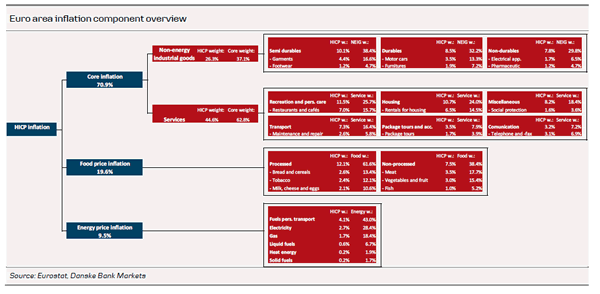The rise in inflation to the ECB’s 2.0% target for the first time since 2013 implies that market expectations have turned in favour of expecting a more hawkish stance from the ECB (a 50% probability of a 10bp deposit rate hike from the ECB is priced in for the end of this year). However, the rise in inflation has so far been driven by volatile energy and unprocessed food price inflation, while the underlying price pressure reflected in core inflation remains subdued. Consistent with weak underlying price pressure, the market is pricing in lower inflation in coming months (down at 0.8% in January 2018), which in our view is in sharp contrast with the expectations of a policy rate hike this year.
In this research piece, we take a close look at what to expect from inflation, with special focus on core inflation as it reveals the underlying price pressure. Based on the communication from ECB members, the latter is highly important for the future monetary policy stance. We expect the ECB to decide on whether to start tapering its QE purchases at the meeting on 7 September. Hence, we consider the inflation figures released ahead of this meeting.
Our conclusion is that the rise in inflation is not a sustained adjustment towards the 2% target, as core inflation is set to print below 1.0% for the next six months, except for one month where it will be lifted by the timing of Easter. The most important reason why core inflation should stay modest is our expectation of subdued wage pressure due to slack in the labour market particularly in the periphery countries but also continued modest wage growth in Germany.
Based on this, we still expect the ECB to announce a third QE extension in September and most likely continue buying assets of EUR60bn per month, as its focus will remain on the underlying price pressure. However, the ECB might continue to remove some of its dovish communications from the introductory statement prior to this but, in our view, this does not mean it will start hiking policy rates or tapering QE towards zero.
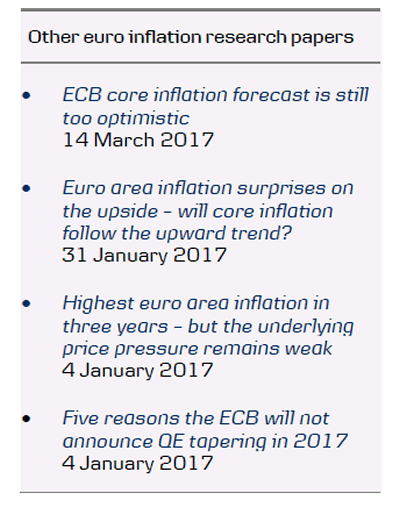
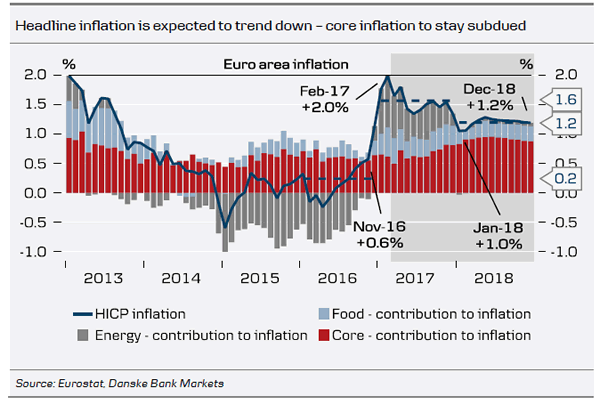
Euro area inflation for the next six months
Inflation in March (released 31 March): we estimate headline inflation took a dip from 2.0% in February to 1.6% in March, driven partly by a drop in core inflation from 0.9% down to 0.7%. If this core inflation figure is correct, it will be the lowest since April 2016. However, our estimate of a decline is due mainly to the early timing of Easter in 2016, causing low inflation in the volatile package holiday prices in March this year. Added to the lower core inflation, the latest decline in the oil price together with less support from base effects in energy prices will also have driven headline inflation lower, although energy price inflation should still have a considerable positive contribution to inflation. Finally, food price inflation has surprised on the upside recently, due mainly to cold weather in the winter months. However, this is unlikely to have continued and we look for a lower contribution.
Inflation in April (released 28 April): headline inflation should go up to 1.8% but only for this month. Core inflation will also rise and for the first time in a year print at 1.0%, but the rise in core inflation is again related to the early timing of Easter last year. This implies the higher figure should not be too encouraging for the ECB as it does not reflect higher underlying price pressure but a temporary rise in prices on package holidays. (In April, package holidays should add 0.1pp more to core inflation than the historical average). We expect the contribution from energy price inflation to be the same as in March based on a fairly stable oil price development. On the other hand, food price inflation should continue lower still, correcting from the strong figures in the cold winter months.
Inflation in May (released 31 May): both headline and core inflation should go lower to 1.4% and 0.8%, respectively. The lower core inflation is reflecting a normalisation following the Easter effect and following this temporary volatility, service price inflation (around 60% of core inflation) should be back around its level in the beginning of this year. Non-energy industrial goods price inflation (the remaining roughly 40% of core inflation) should still be around 0.2-0.3% as there is less tailwind from the EUR weakening and as the indirect support from the higher oil price usually kicks-in with a lag of around 12 months. The lower headline inflation should also follow as the contribution from energy price inflation should go down by 0.2pp compared with April due to less support from base effects. Food price inflation is also set to continue lower in May and print at the lowest level since December.
Inflation in June (released 30 June): we expect headline inflation to decline a bit further to 1.3%, reflecting energy price base effect continues to fade, bringing the contribution to inflation down by another 0.2pp. On the other hand, core inflation should increase slightly to 0.9% as we expect non-energy industrial goods price inflation to go a bit higher as an indirect impact of the higher oil price starting to lift it slowly. Service price inflation is also supported by an indirect impact of the higher oil price, but as the sector is highly dependent on the labour input, the overall figure should remain modest as long as wage growth is subdued. We expect food price inflation to go slightly higher.
Inflation in July (released 31 July): headline inflation is set to go 0.1pp higher to 1.4% but core inflation should remain unchanged at 0.9%, still reflecting the lack of expected upward pressure from wages. The higher headline inflation is instead supported by an increase in energy price inflation as there is a temporary support from base effects during the summer months. Food price inflation should be a bit lower again in July although modestly so.
Inflation in August (released 31 Aug): headline inflation should again go a bit higher to 1.5% but again we expect core inflation to remain unchanged at 0.9%, implying the only month that we expect core inflation to print at 1.0% is in April, where it is lifted by the early timing of Easter last year. In line with the higher headline inflation in July, it is again lifted by a higher support from energy price inflation while food price inflation is modestly lower
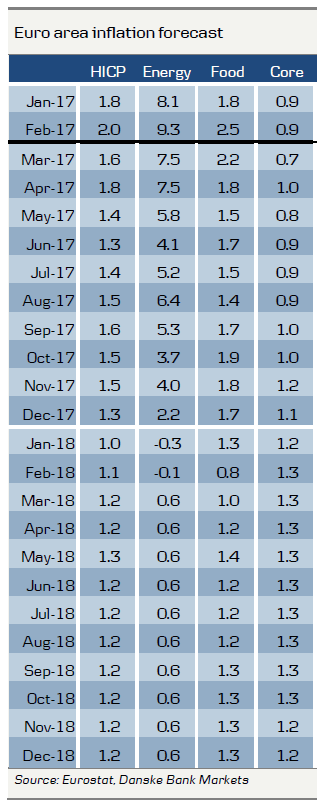
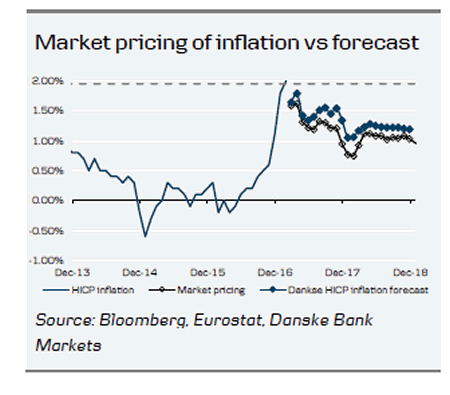
Variation in inflation driven mainly by commodity prices
The recent rise in headline inflation is driven by a lift in energy price inflation. Historically, energy price inflation has explained around 50% of variation in inflation despite its low weight.
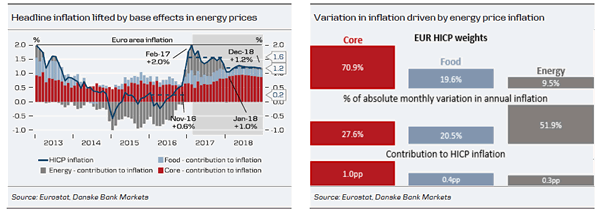
The strong positive contribution from energy price inflation is set to fade as the positive base effects of the very low oil price in early 2016 will not continue to be supportive
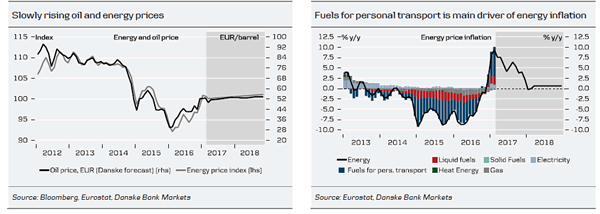
Food price inflation has been lifted recently by unprocessed food prices, due mainly to cold weather. This should correct itself in the spring as indicated by 5% lower commodity food prices
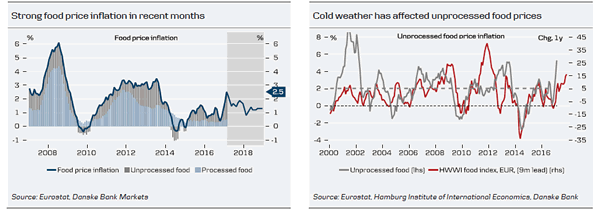
Core inflation drivers
Core inflation is affected by a number of factors but most important is wage growth, as it affects the labour-intensive service prices, which account for around 60% of core inflation.
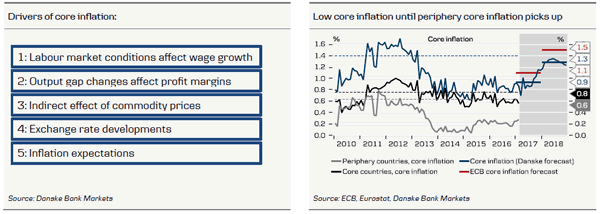
Service price inflation is highly dependent on wage growth but slack in the labour market – particularly in the periphery countries – should result in a long period of subdued wage pressure
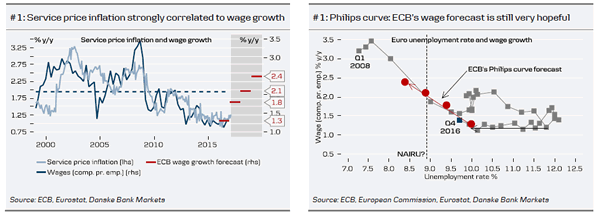
The correlation between the output gap and core inflation is not seen in all countries. Irish core inflation is being kept low by non-energy industrial goods despite a positive output gap.
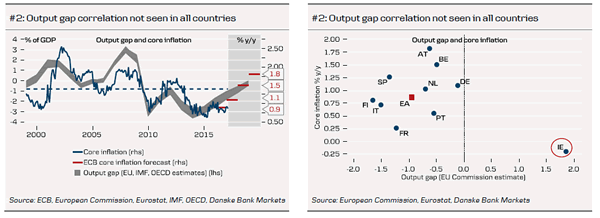
Core inflation drivers (continued)
Core inflation is affected indirectly by commodity prices and the higher oil price has started to lift service inflation, but non-energy industrial goods inflation is affected with a 12-month lag.
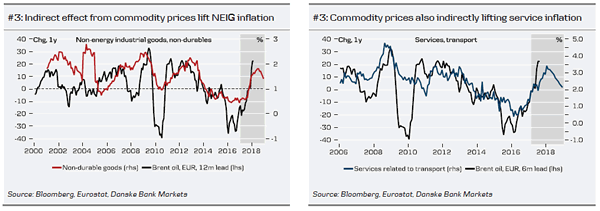
The EUR weakening in 2014-15 supported core inflation and was the main reason why core inflation printed above 1.0% in 2015. The tailwind has since faded and should remain modest
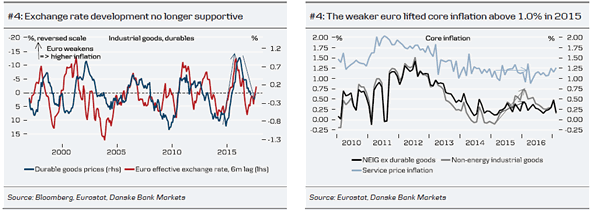
Service price inflation expectations have diverged strongly from the actual inflation figures. Therefore, we do not use these measures as important indicators of core inflation
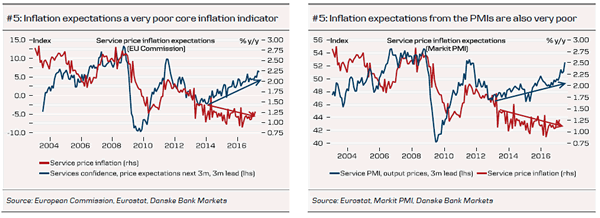
Service price inflation components
Overall service price inflation is determined mainly by the wage pressure but it can be disaggregated into six sub-components where one of them is indirectly related to the oil price
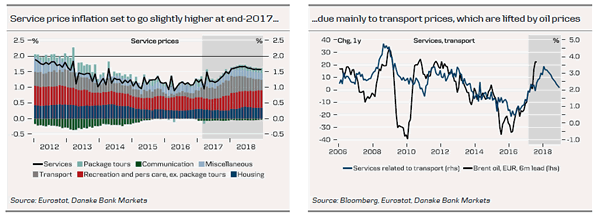
The ongoing recovery is also set to support service price inflation at the end of this year. Likewise, higher house prices and the cost of borrowing are supportive for service inflation.
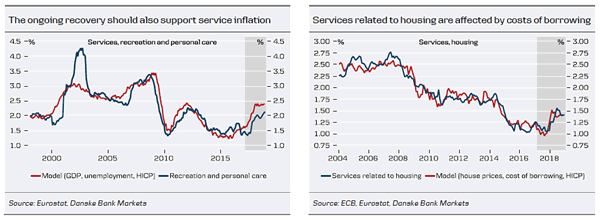
Service price inflation in communication has again turned negative and should remain negative. Prices related to package holidays should add volatility particularly around the Easter months
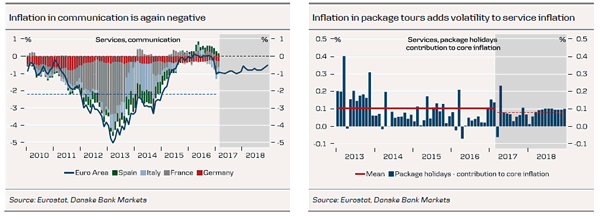
Non-energy industrial goods price inflation components
Non-energy industrial goods price inflation is affected by commodity prices, exchange rate developments and the economic situation, as it affects inflation of clothing and garment prices.
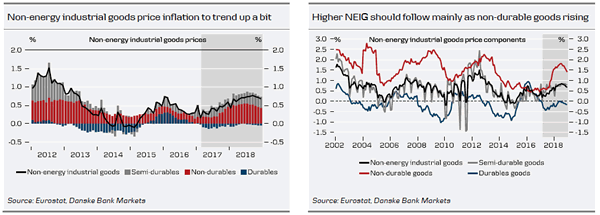
Non-energy industrial goods price inflation is affected indirectly by changes in the oil price but there is a lag. Changes in the effective EUR also affect the core inflation component
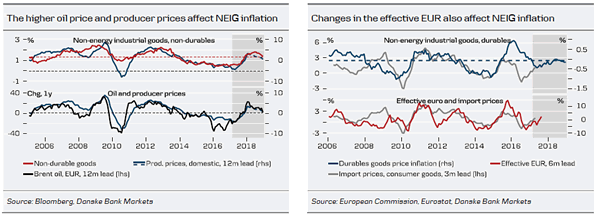
The third component of non-energy industrial goods price inflation (semi-durable) depends mainly on clothing and garments prices and is very volatile. The trend follows durable goods
